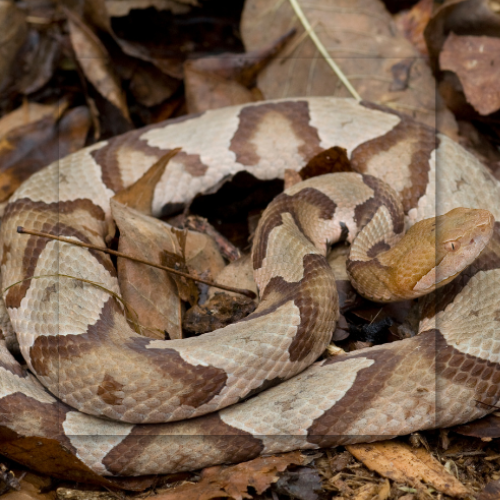
Snake Removal And Control
The fear of snakes is a widespread phenomenon that affects many people, even in modern societies where the risk of encountering these creatures is reduced. This fear, known as ophidiophobia, can be traced back to evolutionary and psychological factors. From an evolutionary standpoint, it is believed that humans developed this fear as a survival mechanism. Our ancestors, living in environments where venomous snakes were a significant threat, would have benefited from an innate wariness of these dangerous reptiles. Psychologically, they possess several characteristics that naturally trigger fear, such as their slithering motion, the scales on their bodies, and their often-hidden presence in natural surroundings. These features can cause an instinctual alarm response in humans, warning them of potential danger.
Identifying Common Snakes In North Atlanta
In Northern Atlanta, residents may encounter a variety of snake species, but there are four that are particularly prevalent. They often venture into suburban settings, particularly during the warmer months, which increases the likelihood of human encounters. Caution and respect for their natural habitat can prevent most negative interactions with these native snakes.
- The Copperhead features a distinctive copper-red head and a body adorned with hourglass-shaped bands of a darker brown on a lighter tan or gray background. They typically measure 2 to 3 feet in length. They can usually be found in mixed forest areas, near rocks, or amidst debris where they can effectively camouflage themselves. They are predominantly terrestrial and prefer to stay grounded. These snakes are relatively passive but can bite if threatened or provoked. Due to their camouflage, they often go unnoticed until they are accidentally disturbed.
- The Eastern Coral has alternating bands of red, yellow, and black, which serves as a warning of its venomous nature. It is small and slender, growing up to 2 feet long. They are found in wooded, sandy, or marshy areas, often hidden under debris or within the soil. They are known for their secretive nature, tend to avoid confrontation and are rarely seen by humans. Despite their venom, they are less likely to bite compared to other venomous species but are extremely dangerous when provoked.
- Rat Snakes typically display a black exterior with a white or cream underbelly. They are large, with adults commonly reaching 4 to 6 feet in length. These snakes are adaptable and can be found in a variety of settings including barns, attics, and trees, and are particularly good climbers, non-venomous and generally harmless to humans.
- Water Moccasins have a heavy, thick body, a blocky head, and can exhibit a dark brown to black coloration. The inside of their mouth is white, which they display when threatened. True to their name, they are found in or near bodies of water like ponds, lakes, marshes, and rivers. They are semi-aquatic and can often be seen basking on the banks or floating in the water. This species is known for its defensive posture, often standing its ground when approached. They are venomous and can be dangerous if provoked.
Attraction Factors And Potential Dangers
Several factors around a home can attract them, making certain environments more prone to encounters with these reptiles. Homes with high populations of rodents and insects may attract species like the Copperhead and Rat Snake, which are in search of food sources. Snakes often seek shelter in cool, dark, and moist places, so piles of wood, compost heaps, unkempt basements, and crawl spaces can provide ideal hiding spots. Properties with water features such as ponds, fountains, or areas with unchecked water leakage can attract semi-aquatic species like the Water Moccasin. Additionally, overgrown vegetation, heavy mulch, and garden ponds not only provide shelter but also hunting grounds, thus increasing the likelihood of them taking up residence near human dwellings.
Copperheads have a venom that can cause severe pain and swelling in humans, with more serious effects in pets and children due to their smaller body mass. Although generally not lethal to humans, the bites require immediate medical attention to manage the symptoms effectively. Eastern Corals, on the other hand, possess a neurotoxic venom that is much more dangerous. A bite from an Eastern Coral can disrupt the nervous system, leading to severe complications such as respiratory failure. Despite their potent venom, Coral Snakes are shy and are less likely to bite unless handled or stepped on.
If you're dealing with snake concerns in your home or property, don't wait for the problem to escalate. Grade A Critter is your trusted local expert in handling snake removal safely and effectively. Our experienced team uses humane and environmentally friendly methods to ensure that your environment is free from these unwanted guests. Contact us today to schedule an assessment and regain peace of mind with our professional snake control solutions.
Frequently Asked Questions
Q1: Can snakes hear, and if so, how do they do it without external ears?
A1: They do not have external ears; however, they are not completely deaf. They sense vibrations through their jawbones, which transmit sound to the inner ear. This unique adaptation allows them to detect ground vibrations, aiding them in locating prey or sensing approaching threats.
Q2: Why do some have two heads, and how common is this?
A2: Two-headed snakes result from the same phenomenon that produces conjoined twins in other animals—a partially separated embryo. This condition, known as bicephaly, is extremely rare and usually occurs in captive breeding more than in the wild. Two-headed snakes face significant challenges, as the heads may have conflicting instincts and desires, making basic activities like feeding and escaping predators difficult.
Q3: Do they ever stop growing, and how long can they live?
A3: Snakes grow throughout their lives, but their growth rate significantly decreases once they reach maturity. The growth rate depends on factors like species, availability of food, and metabolism. As for lifespan, it varies widely among species. For example, while many common snakes live between 15 and 20 years, larger species like pythons and anacondas can live well over 30 years in captivity under optimal conditions.
Grade A Critter
